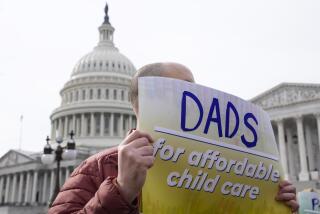Addressing Ill Child-Day Care Dilemma
- Share via
There is no working parent who has not known the panic and frustration of getting up, knowing one must be at work, and being greeted by a distressed child with a fever, runny nose or upset stomach. The ultimate dilemma for working parents, even those who have the best of day care, is what to do when a child is sick. The dilemma recurs for years, from the time a baby or toddler attends group nursery care until the child is old enough to stay home from school alone. Countless “sick days” from American business are taken by well employees who are home caring for sick children.
The problem is a sizable one. Children up to age 2 average 6 to 10 illnesses every year, children 3 to 5 only a few less. Group child care centers almost universally exclude sick children.
The problem for employers and employees who are parents is escalating because the fastest-growing group of children in day care in the country is the group of children who are too young to be “latchkey kids” or to be left at all without adult care. These are children 6 and under, currently numbering 10 million and expecting to comprise two thirds of all children with employed mothers by 1995. The number of children in the United States has fallen by 1.2 million since 1980, according to the Bureau of Labor Statistics, but the number of children with working mothers has grown by 1.5 million. And 90% of the increase are children under 6 whose mothers have gone to work.
These concerns and issues are a part of an information kit that the American Academy of Pediatrics, the 30,000-member organization of physicians specializing in care of babies and children, has sent to pediatricians nationwide. The report includes guidelines for parents and day care centers, and some of the recommendations would change day care immensely if adopted. Surprisingly, children’s doctors would like to see the standards for allowing sick children in group care settings relaxed to be more “reasonable.”
According to Dr. George Stone, chairman of the academy’s Committee on Early Childhood, Adoption and Dependent Care, which drafted the recommendations, “there are very few illnesses for which children need to be excluded from day care.” Most centers do insist that other arrangements be made for all sick children for reasons including lack of facilities for extra care, what the pediatricians’ committee called “excessive” concerns about infecting others or strict state laws or public health policies.
According to the doctors, symptoms of illnesses that may justify keeping a child home are diarrhea, vomiting, high fever and certain types of rashes. However, the committee recommended a number of day care options that would provide for a sick child’s needs--which are described as adequate rest, appropriate diet, proper administration of medications and physical and emotional support. In many cases, these could be provided, but usually are not, by regular day care homes or centers.
Stone expressed doubt about the existing mini-trend toward specialized centers that offer temporary care for children while they are sick. The practice started in California in 1981, he said, and there are about 40 sick-care centers nationwide. Stone said: “Placing a sick child in an unfamiliar environment with previously unknown caretakers would seem to be an extremely poor choice under almost any circumstances.” Rather, the pediatricians recommend that existing day care change to accommodate children with some illnesses and that parents’ employers become more flexible. “It would seem more appropriate for those concerned with the welfare of children and families to work for more reasonable infection policies in existing day care centers, and to take an active role in supporting policies allowing more liberal parental leave in their own offices and institutions,” Stone said.
The Academy of Pediatrics also has formulated guidelines about child health and safety of use to care providers and to parents when they choose a day care facility.
There is indeed, the academy’s committee says, an increased risk for children in day care and their families of contracting infectious diseases, including gastrointestinal disease, hepatitis A and potentially fatal meningitis. However, for many common illnesses, precautions as simple as strict hand-washing routines for both staff and children significantly decrease the spread of infections. This is the “simplest and most important way to control infections in day care,” the committee said. Children should be taught how and when to wash their hands properly (after using the toilet and blowing their noses, before tooth brushing and before and after eating). The pediatricians also recommended that all day care employees have health assessments including tuberculosis tests and that children in day care be fully immunized. Factors that contribute to the spread of infection in centers include overcrowding of children in close physical contact, understaffing or poor training of staff, lack of policies for the management of sick children, poor ventilation and insufficient numbers of toilets and sinks.
Children in day care should be separated into age groups, the doctors said, of infants, children in diapers and older children. Toilet and diapering areas should be separate from food areas, and each area should be cleaned after every use. A sanitizing solution should be used to rinse toys and surfaces in infant and toddler areas. Children should not share the kinds of objects they put in their mouths--which include just about everything for small children. Stuffed animals that are not machine-washable should not be allowed in day care centers, and washable ones should be washed often and not shared.
Regarding safety issues, the academy said the top six hazardous products that cause injury to children are climbing equipment, slides, hand toys and blocks, other playground equipment, doors and indoor floors. The U.S. Consumer Product Safety Commission says that more than 70% of play equipment injuries result from falling, and recommends that all elevated surfaces used by children that are 30 inches or more above another surface should have protective barriers.
Other recommendations made by pediatricians that parents could use when assessing centers are that doors have devices to prevent quick closing and safety glass panels so that children can see through the doors; stairway handrails children can reach; railings on all elevated areas accessible to children; windows above ground level equipped to prevent opening more than six inches.
Other hazards: Styrofoam cups and plastic forks which can be easily broken and choked on; heat sources accessible to children; art materials such as powdered clay and paint, dyes, permanent markers and instant glues; poisonous plants.
In addition to the information kit, the Academy of Pediatrics has issued a second edition of “Health in Day Care: A Manual for Health Professionals.” Written for doctors, it includes expanded and updated information for physicians to enable them to better assist parents in choosing and evaluating day care.
More to Read
Sign up for Essential California
The most important California stories and recommendations in your inbox every morning.
You may occasionally receive promotional content from the Los Angeles Times.










